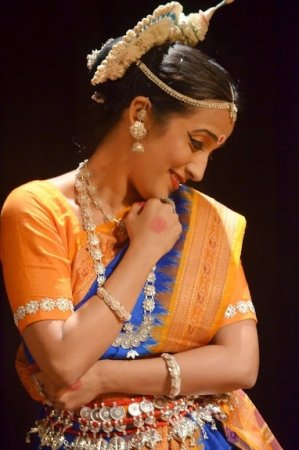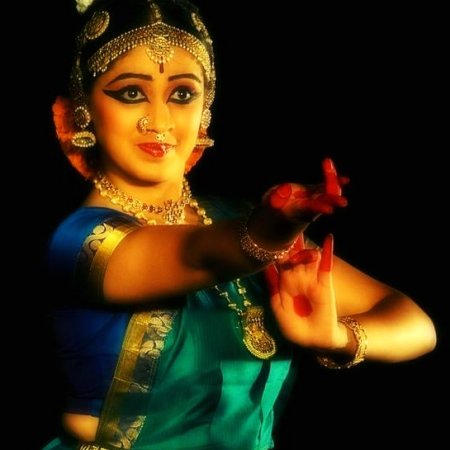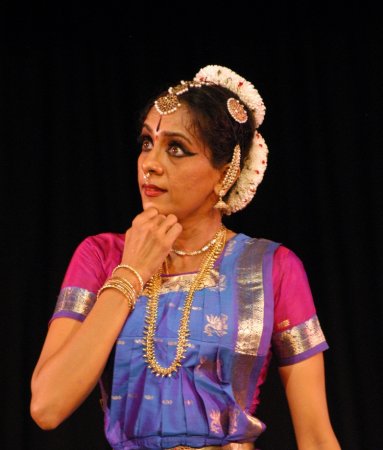
|
 |

|
 |
Indian dance: From real to virtual - Rashika Ojha e-mail: rashikalib@gmail.com June 9, 2020 Covid-19 situation... It's a strange feeling. Life is moving, yet it is still... A still movement, where you are not mobile, yet your idea and intention travels. When I asked Jaya C Mehta, an Odissi dancer from Delhi, about her lockdown trials, she unveiled, "I would like to see how my ideas of beauty and silence, can be shared on digital platforms as a kind of antidote to the stress of today's times." For a dancer practicing Indian classical dance, the journey from an idea to the form is not an independent journey; instead it's a collaborative journey which you tread painstakingly. For this, you need to work in coordination with others like the orchestra and sometimes mentors for feedback and direction to co-exist in the world of "performance syndrome" (a term I borrow from Leela Venkatraman, a renowned dance scholar and critic). For me, a mother of two little ones, staying away from family in a new country, it's a challenge to work on new projects and pieces. Especially when your colleagues are investing time and energy in new ideas, you are slow and don't have new things for others to hear. Your story is weak and less interesting, although there are many other interesting stories beneath the face of a weak and boring life story. Well, this changed with the onset of the Corona virus into our worlds. The Covid-19 situation is not a normal or pleasant situation but it has brought us to a new understanding of life. Where movement is banned and distances are respected. Now life is redefined and nodes of indulgence changed.  Jaya Mehta  Shweta Venkatesh For a dancer, the option was virtual space for teaching, learning and performing. "I quickly switched to teaching online as lockdown started. We learnt different techniques, me dancing with students, each student making an audio-video for feedback and sometimes portions of a choreography presented by chosen students for detailing," shares Jaya C Mehta. On the other hand, Prabha Nambiar, a Mohiniattam dancer and teacher in Dubai shares the challenges of online teaching and how it cannot replace the one-to-one training in a classroom space. "With online teaching, internet fluctuations are a major concern; there is always a lag, the beats (of prime importance) are not heard well in time, there is always a glitch happening, thus disrupting the continuity of a class but it's the need of the hour." There are many questions about the virtual space and its engagements. But we all understand it's the best we can do in these difficult times of uncertainty and fear. It's a new life for me and many others like me. When I say 'me', I don't mean to sound like the underprivileged one, but someone who has decided and chosen to prioritize certain conditions in her life. I haven't been able to travel for dance, the web space has enabled me to start traveling in times and spaces. To confirm this, Shweta Venkatesh, a young and versatile Kathak and Bharatanatyam artiste in Bangalore adds, "Dance is in its form a challenge, teaching is yet another challenge. In the current challenging situation, if I can help someone with teaching then I am ready to accept the challenge." A young dancer who is all set for the changing world. The online teaching module is not a new idea for some. A renowned senior guru and dancer, Shobanaa Bhalchandra shares, "I was one of the first teachers to begin online teaching for students living in America and have been doing it for the past 12 years. Initially it was a challenge because of the lag but gradually I got used to it. The lag is not for the students but for us to understand and assess the students. A combination of online sessions and one-to-one learning can save time for everyone and lead to a complete learning. One saves a lot of time with online learning. We need to know how to use technology to its best, and I whole heartedly welcome online classes."  Shobanaa Bhalchandra The performance and learning space have multiplied, erased all boundaries and taken many avatars. It's a living room, a bedroom, a lobby, a patio, a corner or front yard, anything and everything available to suit your intention and spirit. Learning space has adapted to new modes of gallery view, video recording for reference and video recording for review and comments. Today, the world is celebrated to be a global village but truly distances were shrinking for some and expanding for some others. Instead, the virtual space has weakened the borders and strengthened the bonds to connect all to each other. Yet Vani Bhalla Pahwa, a Mohiniattam dancer from Delhi talks about, "Internet as an option - it's an option with caveats. For remote students it opens up an option no doubt... but not everything can be plucked from offline and planted online." Before Covid-19 pandemic, I wasn't teaching or learning actively. Now, I am actively teaching and participating in learning deeper nuances of Indian dance. I am happily attending an ongoing process of unraveling the concept of Ashtanayika under the able guidance of Guru Shobanaa Bhalchandra. It's fascinating to see the web transcend time and space, creating new avenues and experiences. It's a dreamlike reality. It's like a sringara sequence from a Padam, where the heroine believes or dreams to have traveled to another time and space with the hero where she is in his arms, in bliss of love. So often we are transported in time through our art and imagination, creating experience of the unseen and unknown. Indian dance has always been dangling between two spheres. Today, it's the real and virtual. Critic Leela Venktaraman talks about this dichotomy as 'negotiating between extremes' and has summed it up as an article where she reflects on the duality of Indian dance. I wonder what will happen to these recreated spaces online once the world moves back to normal. Will the virtual collaborate with the real or will it null itself in the void and darkness of the web? Will I again be distanced? Or will the two worlds still co- exist 'negotiating extremes'?  Rashika Ojha Abrol is a Bharatanatyam exponent trained under the tutelage of Guru Saroja Vaidyanathan. She has her Bachelors in English Literature, Hindu College and Masters in Arts and Aesthetics, JNU. Rashika is interested in research on all kinds of arts especially performing arts. She is a freelance writer. Post your comments Please provide your name and email id when you use the Anonymous profile in the blog to post a comment. All appropriate comments posted with name & email id in the blog will also be featured in the site. |